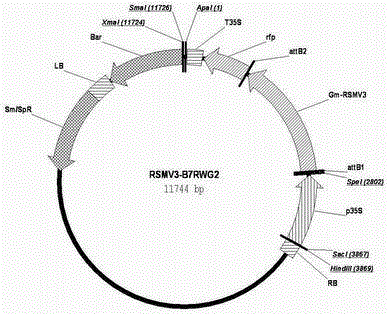Soybean antiviral gene and application thereof
A technology of soybean mosaic virus and soybean, applied in application, genetic engineering, plant genetic improvement, etc., can solve problems such as unsatisfactory variety resistance
- Summary
- Abstract
- Description
- Claims
- Application Information
AI Technical Summary
Problems solved by technology
Method used
Image
Examples
Embodiment 1
[0048] Example 1. Acquisition of disease-resistant transgenic plants
[0049] 1. Identification and cloning of disease resistance genes
[0050] 1. Identification of disease resistance genes:
[0051] (1) Plant material processing and material collection: The soybean variety Rsmv with broad-spectrum and high resistance to soybean mosaic virus disease was used as the resistance gene donor material, and the susceptible soybean variety Ssmv was used as the control material. Sowing, 15 plants of each kind. The growth conditions were 27°C and 18°C for day and night, respectively, and a photoperiod of 17 hours of light and 7 hours of darkness. After the soybean seedlings grow until the second three-edged compound leaf is fully unfolded, inoculate the soybean mosaic virus and the blank control buffer on the first three-edged compound leaf respectively, and wait for the symptoms (yellow spots on the leaves of the susceptible variety) to appear. , and the leaves at different disea...
PUM
 Login to View More
Login to View More Abstract
Description
Claims
Application Information
 Login to View More
Login to View More - R&D
- Intellectual Property
- Life Sciences
- Materials
- Tech Scout
- Unparalleled Data Quality
- Higher Quality Content
- 60% Fewer Hallucinations
Browse by: Latest US Patents, China's latest patents, Technical Efficacy Thesaurus, Application Domain, Technology Topic, Popular Technical Reports.
© 2025 PatSnap. All rights reserved.Legal|Privacy policy|Modern Slavery Act Transparency Statement|Sitemap|About US| Contact US: help@patsnap.com



